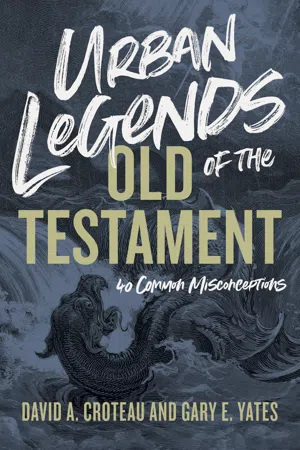
- 288 pages
- English
- ePUB (mobile friendly)
- Available on iOS & Android
About This Book
Urban Legends of the Old Testament surveys forty of the most commonly misinterpreted passages in the Old Testament. These "urban legends" often arise because interpreters neglect a passage's context, misuse historical background information, or misunderstand the original language of the text. With a pastoral tone and helpful explanations of where the error originally occurred, authors David A. Croteau and Gary E. Yates tackle legendary biblical misinterpretations of topics like the origin of evil or the purpose of Mosaic food laws, as well as common misconceptions about dinosaurs, or NASA discovering Joshua's long day. Urban Legends of the Old Testament will help readers avoid missteps in the interpretation of key biblical texts while modeling interpretative techniques that can also be applied to other Old Testament passages.
Frequently asked questions
Information
CHAPTER 1

In the “Gap” between Genesis 1:1 and 1:2, Satan Fell
Genesis 1:1–2
The Legendary Teaching on the “Gap Theory” in Genesis 1
Countering the Legendary Teaching
“Formless and Empty”: An Indication of Divine Judgment?
The Gap Theory and the Grammatical Structure of Genesis 1:1–3
| Traditional View |
| Gen 1:1—God’s initial act of creation |
| Gen 1:2—Conditions resulting from God’s initial act of creation |
| Gen 1:3—“Then God said” (God’s creative work resumes) |
| Precreation Chaos View |
| Gen 1:1—Title for chapter |
| Gen 1:2—Conditions that exist prior to God’s work of creation |
| Gen 1:3—“Then God said” (God’s first creative act in the chapter) |
The Message and Purpose of the Creation Account in Genesis 1
Table of contents
- Acknowledgments
- Prologue
- 1. In the “Gap” between Genesis 1:1 and 1:2, Satan Fell, Genesis 1:1–2
- 2. The Trinity Is Directly Taught in Genesis 1:26, Genesis 1:26
- 3. Women Were Created Inferior to Men, Genesis 2:18–20
- 4. The Virgin Birth Was Prophesied in Genesis, Genesis 3:15
- 5. Radical Islam Has Inherited Ishmael’s Violent Spirit, Genesis 16:12
- 6. The Angel of the Lord Refers to the Preincarnate Jesus, Genesis 18:1–13
- 7. Taking the Lord’s Name in Vain Refers to Using God’s Name as a Curse Word, Exodus 20:7
- 8. The Tabernacle Was an Elaborate Picture of Jesus, Exodus 25–40
- 9. Unintentional Sin Is Inconsequential, Leviticus 4–5
- 10. The Mosaic Food Laws Were about Healthy Living, Leviticus 11
- 11. The High Priest Wore a Rope around His Ankle on the Day of Atonement, Leviticus 16
- 12. Old Testament Saints Were Saved by Keeping the Mosaic Law, Leviticus 18:5
- 13. Using the Mosaic Law to Label Homosexuality as Sinful Is Logically Inconsistent, Leviticus 18:22 and 20:13
- 14. The Tithe in Ancient Israel Was 10 Percent of Income, Leviticus 27:30–33
- 15. The Old Testament Law Is Divided into Three Parts, Deuteronomy 6:1
- 16. God Never Expected Israel to Keep His Law, Deuteronomy 29:4
- 17. NASA Found Joshua’s Long Day, Joshua 10:12–15
- 18. You Can Know God’s Will by Putting out the Proverbial Fleece, Judges 6
- 19. God Never Wanted Israel to Have a King, 1 Samuel 8–12
- 20. Christians Should Never Question the Authority of Church Leaders, 1 Samuel 24–26
- 21. If Americans Repent, God Promises to Fix Our Nation, 2 Chronicles 7:14
- 22. Behemoth and Leviathan Are Dinosaurs, Job 40–41
- 23. Psalm 22 Directly Predicts the Crucifixion of Jesus, Psalm 22:16
- 24. Imprecatory Psalms Are Horrible Models for Christian Prayer, Psalm 109
- 25. Psalm 116 Teaches How God Welcomes His Saints at Death, Psalm 116:15
- 26. Proper Parenting Guarantees Godly Children, Proverbs 22:6
- 27. Without Vision, People Perish, Proverbs 29:18
- 28. Proverbs 31: A Checklist for the Perfect Wife, Proverbs 31:10–31
- 29. “Under the Sun” in Ecclesiastes Refers to Life without God, Ecclesiastes 1:2–3
- 30. The Song of Songs Is a Biblical Model for Dating and Marriage, Song of Songs 3:6–5:1
- 31. Isaiah 9 Contains a Prophecy against Post-9/11 America, Isaiah 9:10–11
- 32. Isaiah 14 Portrays the Fall of Satan, Isaiah 14:12–15
- 33. God Created Evil, Isaiah 45:7
- 34. God’s Word Will Never Return Void When We Preach and Evangelize, Isaiah 55:11
- 35. God Has Promised You a Bright and Prosperous Future, Jeremiah 29:11
- 36. The City of Babylon Must Be Rebuilt to Fulfill Prophecy, Jeremiah 50–51
- 37. God Intended “Ezekiel Bread” to Be a Health Food, Ezekiel 4:9
- 38. Gog of Magog Refers to the Leader of Russia, Ezekiel 38–39
- 39. Jonah’s Preaching Produced the Greatest Revival Ever, Jonah 3
- 40. Christians Must Bring Their Whole Tithe into the Local Church, Malachi 3:8–10
- Epilogue
- Name Index
- Scripture Index
- Subject Index